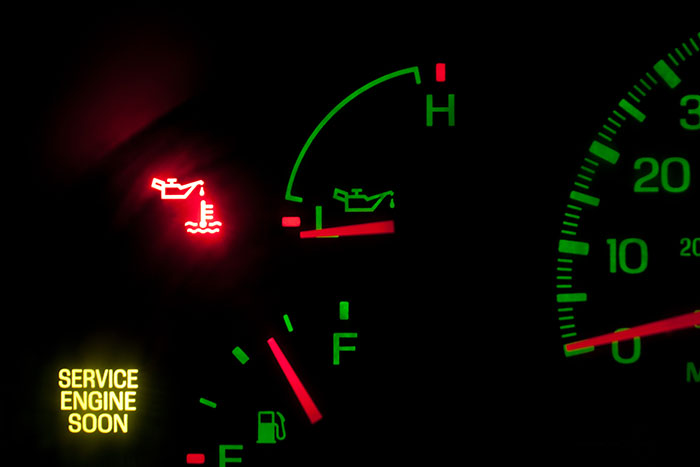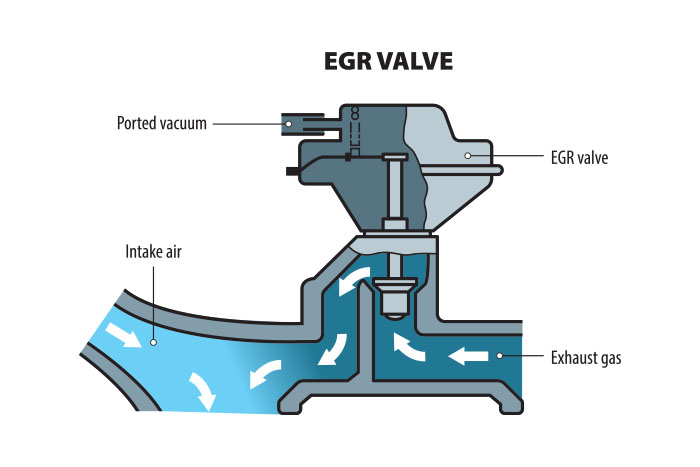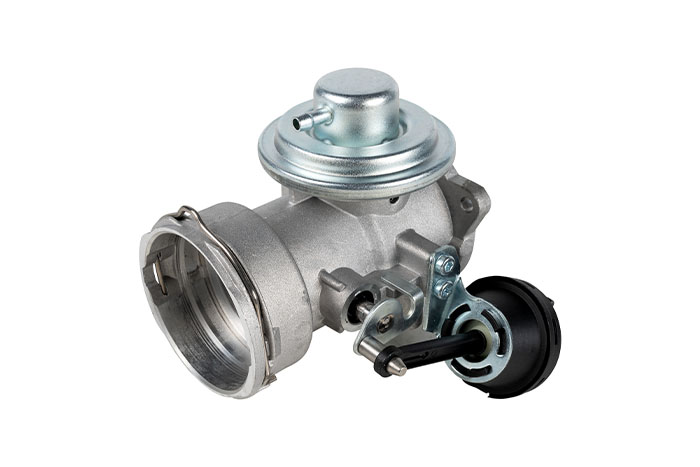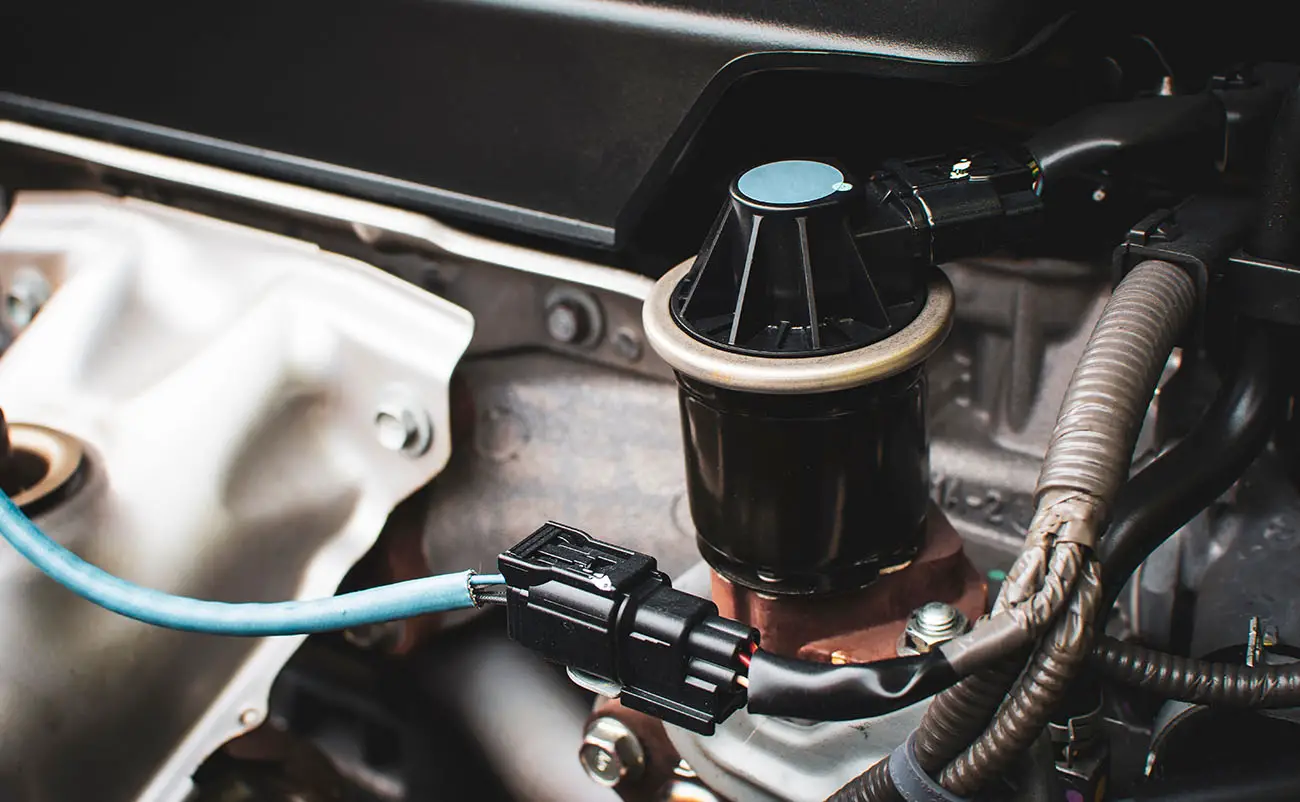Your car’s EGR valve, or exhaust gas recirculation valve, performs an essential function by helping to reduce the amount of nitrogen oxide (NOx) emissions from your vehicle. Over time, this valve can become dirty and clogged. A clogged EGR valve can lead to many noticeable problems with your car, and you will need to either clean or replace the valve. So how can you tell when your EGR valve is going bad? There are several different symptoms that you can watch for. Keep reading as we give you seven symptoms of a bad EGR valve and offer some tips for cleaning or replacing the valve.
Table of Contents
Symptoms Of A Bad EGR Valve

The EGR valve is the heart of your vehicle’s EGR system, and a faulty EGR valve will lead to noticeable problems with your vehicle. Not only that but burning fuel or hydrocarbons inside your engine without a properly functioning EGR system will lead to increased pollutants in the atmosphere. Here is what you need to watch for so that you know when to replace or clean your EGR valve.
#1. Engine Stalls At Idle
A normally working EGR valve can open and close so that the proper amount of exhaust gas is recirculated into the combustion chamber. At idle, a clogged EGR valve will not properly regulate the recirculation of the exhaust gas. This can commonly lead to a rough idle, but it can also cause stalling at idle. The rough idle or stalling is a result of your engine’s air/fuel ratio being too rich or too lean. The air and fuel mixture needs to be within the proper spec for the engine to run perfectly, and an EGR valve problem will cause this mixture to be off.
#2. Reduced Fuel Economy
Reduced fuel efficiency is one of the common symptoms of a bad EGR valve. Carbon deposits can build up inside the valve and cause it to get stuck in the open position. When the valve is stuck in the open position, the exhaust gases are constantly recirculating — even when they shouldn’t be. This causes the temperature in the intake manifold to be lower than the normal operating temperature. High temperatures are required to burn fuel in the engine properly. When the temperature is too low, the fuel does not burn efficiently. This means that your car’s engine will require more fuel to operate than it should, and you will start to notice this at the gas pump.
#3. Poor Engine Performance
If you have noticed your engine hesitating or sputtering, it could be due to a failing EGR valve. When the valve gets stuck — either in the open position or the closed position — it allows either too much or too little exhaust gas into the intake. This can result in either rich or lean running conditions. Similarly, too much fuel caused by a failing EGR valve can cause your spark plugs to foul out quickly. This will result in engine misfires and performance problems. While poor engine performance can also be the sign of other problems, like a symptom of a bad fuel filter, it often points to a faulty EGR valve.
#4. Smell Of Gasoline
If you smell gasoline as your car runs, it could be the result of a failing EGR valve. The bad valve could be causing your air/fuel mixture to be extremely rich. This means that too much gasoline is getting into the combustion chamber, and all the fuel is not getting burned. This fuel-rich mixture passes through the exhaust system and out the tailpipe. This increases your NOx emissions and causes a bad smell. In addition, the exhaust gas may be harmful to your health, and your fuel consumption will increase. If you notice the smell of gasoline as your car runs, it’s likely time to check your EGR valve.
#5. Failed Emissions Test
Modern cars have advanced exhaust systems that remove hydrocarbons and harmful gases from your car’s exhaust. The flow of exhaust gases passes through the catalytic converter and then out the tailpipe. However, if the exhaust gas contains excess fuel, it can damage your catalytic converter and cause you to fail your emissions test. Many states require annual emissions inspections, so you might need to perform an EGR valve replacement before your vehicle passes the test.
#6. Check Engine Light
There are many different things that will cause your check engine light to illuminate, and a bad EGR valve is just one of them. Many of the symptoms associated with a bad valve will also cause your check engine light to illuminate. You can use a scan tool to read the trouble codes from your car’s ECU, and most automotive repair shops will do this for you. The trouble codes might reveal a misfire, although a malfunctioning EGR valve might be the root cause of the misfire. If you need help troubleshooting, you should seek the help of a qualified mechanic to resolve the issue and get that pesky light to go away.
#7. Knocking Noise From Engine
Engine pinging is not good for your car’s motor, and it can be the result of a bad EGR valve. Since a bad valve does not allow the exhaust gases to be recirculated properly, it can lead to an extremely lean air/fuel ratio. When your vehicle is running lean, it will lead to early detonation in your combustion chamber. This means that the fuel mixture ignites and burns before the spark plug fires. You can hear your engine knocking when this happens, and pinging is one of the most common signs of too much air in your combustion chamber. If you hear a knocking sound coming from your engine, it might be time to clean or replace your EGR valve.
What Is An EGR Valve?

So, what does an EGR valve do? An EGR valve might sound complicated, but the way that it works is quite simple. As with all valves, your EGR valve can be either open or closed. The position of the valve either allows some of your exhaust gas to recirculate into the intake manifold or exit out the tailpipe. The primary purpose of the EGR valve is to help reduce emissions. Instead of passing all the harmful exhaust gases out of the tailpipe, some of those gases are recirculated into the engine.
Most modern vehicles have EGR valves, including both gas and diesel engines. There are a couple of types of EGR valves. One type of EGR valve opens and closes using a vacuum hose when a vacuum is created in the engine. The other type of valve is controlled electronically by your car’s ECU. The electronically controlled valve is much more efficient, and that is the type of valve found on most modern cars. These valves have a position sensor or EGR sensor, and the car’s computer can control them very precisely using a small solenoid. Older cars typically have a vacuum-controlled valve, although you should be aware that a simple vacuum leak can affect the function of your EGR valve.
Clogged EGR Valve Cleaning Options
So, can you clean a clogged EGR valve, or must you always replace it with a new one? Luckily, cleaning your EGR valve is an option. There are a couple of ways you can do this. First, you can run a bottle of fuel system cleaner or catalytic converter cleaner through your vehicle. The Rislone Cat Complete cleaner is a great option for this method. This is the easiest method of cleaning your EGR valve because you simply need to pour the solution into your fuel tank and run your car. However, if you have a lot of carbon buildup in the valve, this method is not likely to clean it very well.
In that case, you will need to remove the EGR valve and clean it more thoroughly. After removal, you can soak it in a cleaning solution, like this EGR system cleaner. After allowing the valve to soak, you can use a brush or other tool to remove the rest of the deposits that are stuck. This is the most thorough way to clean the valve, and this method is almost always necessary with a valve stuck open or closed.
Replacing A Faulty EGR Valve
Replacing a faulty EGR valve is not extremely difficult in most cases. First, you will need to locate the valve. The valve is usually located near the rear of the engine and attached to the intake manifold. It will usually have a tube running to the exhaust manifold as well. Once you locate the valve, you should see a couple of screws holding the valve in place. You need to remove those screws and any hoses attached to the valve, and then you can remove it from the engine.
To reattach the new valve, simply complete the steps above in reverse order. Make sure you put a new gasket on when replacing the valve. Failure to replace the gasket can result in leaks, and it might mean that the new valve does not function properly. Although this is not an overly complex job, you should always seek the help of a qualified mechanic if you feel that you cannot properly perform the job. Many people wonder how to test an EGR valve. Testing the valve is usually a task best left for a mechanic.
EGR Valve Replacement Cost

How much does an EGR valve cost? The cheapest option for fixing the problem is cleaning your EGR valve without replacing it. A bottle of cleaner usually only costs about $25. If your EGR valve does need to be replaced, the cost varies depending on the make and model of your vehicle. On average, it will cost you about $200 to $300 to have a mechanic replace the EGR valve on your car. For high-end vehicles, this cost will be higher. Replacing the valve on a Mercedes or BMW can cost you $500 or more.
If you decide to replace the valve yourself, you can save some money on labor charges. The part will usually only cost you $40 to $150 in most cases. Replacement will usually take a qualified mechanic about an hour, so you will usually save $100 to $200 in labor by doing the job yourself.
The Bottom Line
A clogged EGR valve can cause many problems, including low combustion temperatures, pinging, stalling at idle, and a check engine light. If the EGR valve is simply clogged with carbon deposits, you can usually clean it. However, if the valve is faulty, then you will need to replace it. Replacing the EGR valve is not an extremely difficult job, although it will cost you a couple of hundred dollars if you have a mechanic do the job.
Frequently Asked Questions
What are the common causes of a bad EGR valve?
Carbon buildup is one of the most common causes of a bad EGR valve. As your engine runs, hydrocarbons pass through the exhaust and start to build up inside the EGR valve. Newer EGR valves can also have problems with the solenoid that controls the movement of the valve. When the valve does not move properly, the exhaust gases cannot recirculate properly. On older vehicles, a vacuum leak is the most common cause of a malfunctioning EGR valve.
What is the difference between a bad EGR valve and a dirty EGR valve?
A bad EGR valve has a mechanical or electrical problem that prevents proper operation or movement of the valve. The solenoid that controls the valve could be faulty, or there could be other issues that prevent proper movement. On the other hand, a dirty EGR valve is clogged with carbon buildup. As soon as a dirty valve is cleaned, it will begin to operate properly. Even if a dirty valve is stuck open or closed, the valve will function properly once it has been cleaned thoroughly.
Can I drive my car with a clogged EGR valve?
It is not a good idea to drive a vehicle with a clogged EGR valve. While you can technically drive your vehicle with a clogged EGR valve, you should not continue to drive it for extended periods of time. A clogged valve can cause your engine to stall, and it can also cause harmful emissions from your tailpipe. In addition, you might be burning more fuel than necessary due to decreased fuel economy. If you have a clogged EGR valve, you should either clean or replace it as soon as possible.

